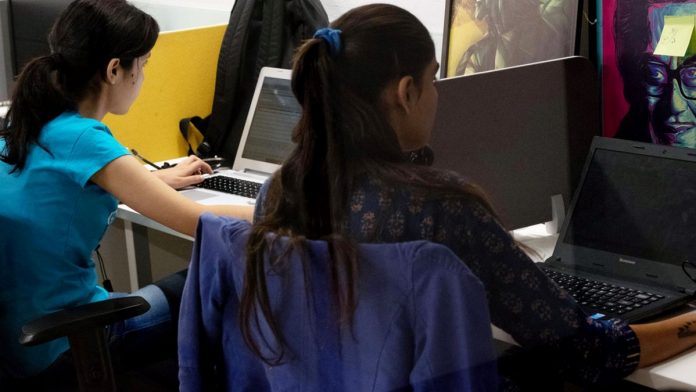Empowerment for women has been linked to their claiming the public sphere of work and gaining financial independence. The usual rhetoric that accompanies such notions of empowerment is that financially independent women have more choices. While such ideas conjure a world full of possibilities for women who reach the finish line of economic independence, the new World Bank report has hit hard at all speculations of freedom, choice and empowerment with a stark statement- the global gender gap for women in the workplace is far wider than thought and no country provides equal opportunity for women, not even the wealthiest economies.
From an economic perspective, reducing gender gaps in labour force participation could substantially boost global GDP by more than 20%, the report states.
From an economic perspective, reducing gender gaps in labour force participation could substantially boost global GDP by more than 20%, the report states. The two indicators that have been used for analysing the obstacles that women face in entering global workforce and contributing significantly towards the welfare of themselves, their families and communities are women’s safety from violence and access to childcare services. Surveys in 190 economies showed that when such coordinates of analysis are taken into account women on an average enjoy only 64% of the legal protections that men do which is alarmingly below the 77% estimate of the previous reports.
The legislation-implementation gap
While major reforms since 1970 have improved women’s legal rights globally, the massive global gender gap shows that many critical areas have been overlooked in analysis so far and “progress” has also been overestimated. The Women, Business and the Law report of 2024 brings out a comprehensive picture of the gap in legislation and implementation of legal reforms pertaining to gender. The report shockingly reveals that women enjoy only two-thirds of the rights of men. Countries on an average have established less than 40% of the systems needed for full implementation and enforcement mechanisms required to address the reform measures as legislated.
Thus although consistent reform efforts may be seen in a number of growing economies, given the global insistence on equal pay, equal opportunities, women empowerment, the lack of supportive mechanism to implement such laws does not bring about the projected effect in addressing gender gaps at workplace.
Childcare services gap
With respect to childcare services the report showed concern on how only less than half of the countries had schemes to provide financial support or tax relief for parents of young children. Only less than a third had quality standards in place for childcare that could assure parents of their children’s safety. In 81 countries, a woman’s pension benefits do not account for periods of work absences related to childcare. In India, Child Care Leaves are administered only to permanent government employees for a period of two years with proper financial benefits.
However, the obvious prevalence among women to avail such leaves often renders their potentials and positions at the workplace questionable, thereby, attaching stigma to the very availing of the benefit. When women spent an average of 2.4 more hours a day on unpaid care work than men, especially the care work of children, extending access to child care benefits can obviously increase women’s participation in the workforce in all sectors and job conditions. However, the absence of such services and benefits, except for a certain section of employees becomes a deterrent for many women who often have to choose childcare over employment opportunities.
When women spent an average of 2.4 more hours a day on unpaid care work than men, especially the care work of children, extending access to child care benefits can obviously increase women’s participation in the workforce in all sectors and job conditions.
Also indiscriminate usage of such leave benefits in undisciplined work cultures, like most government sectors, also defeats the very motive of such benefits, making it impossible to grasp its need for working women within patriarchal work cultures like in India. In around 62 economies, the ages at which men and women retire are different. Moreover, since women live longer than men, receive lower pay, take time off from work when they have children, they end up getting smaller pension benefits and greater financial insecurity in older ages.
The safety measures gap
The greatest concern evoked by the report is pertaining to women’s safety where it is found that women enjoy merely a third of the needed legal protection against domestic violence, sexual harassment, child marriage and femicide. The laws prohibiting sexual harassment in the workplace are more than those in public spaces. This renders public spaces unsafe for women thereby affecting women’s use of public transport to get to work.

Consequently, unavailability of safer and cheaper means of transport narrows down options for women in terms of career types, job locations, working hours and so on. This constricts women to stereotypical, unstable, low paying jobs closer to homes or areas they are acquainted with. Thus while a personal preference can definitely be considered as playing a key factor in determining whether a woman would engage in paid work or not, we cannot lose sight of the fact that such preference is heavily influenced by socio-economic constraints, safety issues and the pressure to conform to traditional gender roles. Social and financial privilege also play an extremely significant role in ensuring better opportunities for women who can migrate to urban centres from smaller and peripheral towns.
International Labour Organisation reports and India
While analysing the reasons for gender gap in the labour market, ILO dwells on how the reinforcement of the male breadwinner bias in developed and emerging economies often make it less likely for women to actively look for a paid job or risk their traditional roles as women at home to look for economic stability. ILO also considers religion as having a restrictive impact in women’s work force participation, thereby pointing out that women’s access to quality employment opportunities remains considerably restricted around the world.
Zooming into the employability gender gap in India one may be confronted with more uncomfortable facts. ILO states that employability gender gap in India is 50.9% with only 19.2% of women in the labour force compared to 70.1% of men. India is one of the five nations, among China, Pakistan, Azerbaijan, and Qatar, where gender based inequalities exceeds 5%. The pandemic has been suggested as one of the causes for the halting of progress towards gaining gender parity leading towards ‘shecession’ especially in retail and hospitality sectors where women are more prevalent.
It is important to note that women are not only the first to “sacrifice” work for family, they also constitute a considerable portion of those who have stopped searching for jobs after repeated unsuccessful attempts.
Women’s inability to secure proper employment has surfaced as an existent problem in employability data narratives where women are most likely to be victims of vulnerable employment, exploitative and low-paying jobs, overwork, unsafe work conditions, sexual harassment and the like. The contraction of public sector jobs has further worsened the scenario for women without privileges. It is important to note that women are not only the first to “sacrifice” work for family, they also constitute a considerable portion of those who have stopped searching for jobs after repeated unsuccessful attempts.
The possible solution and its plausibility
While an inclusive environment that empowers women, continuous challenge to stereotypical ideas of women’s work, promotion of safety and security measures, implementation of gender-responsive policies to safeguard women’s rights and women’s claim to becoming risk-taking subjects are possible ways of solving the problem of gender gap in work force, should the plausibility of these solutions not be questioned, especially when the gap persists despite global initiatives taken to reduce it?
Wherein lies the problem? Harvard Business School experts state that while steering through work-life balance has been considered as the most important factor that restraints women from advancing in their careers, this might only be a partial reason since men too suffer from imbalance in work-life and yet advance in their careers.
They suggest that what hinders women in progressing is that they are often encouraged to go part-time and motivated towards less challenging roles which stunt their potential and derail their career because long working hours are a problem for them. In fact the real culprit is the general culture of demanding overwork which hurts both sexes, but more so in case of women, who must then make accommodations like going child free, remaining unmarried, options which are available to the privileged few, options which do not dismantle the traditional prejudices attached to women’s lives but only reinstate it.
The HBS research, therefore, insists on creating a work ambience that supports freedom from hustle culture, has reasonable working hours, and accommodates a culture of rest. This would lead to sharing of responsibilities, thereby, allowing women to achieve workplace equality with men. While this can surely be an effective solution, the question is: will the monstrous growth of capitalist economy support such an overhaul in work culture, especially when AI is ushering in a culture of unimaginable speed? May be women as usual will continue to bear the brunt of change and progress, until work cultures learn to accommodate imbalance, loss or defeat with a sporting spirit.
About the author(s)
Priyanka Chatterjee is a mother, researcher, and academic. She lives and writes from Siliguri. Her articles have appeared in Feminism in India, LiveWire, Himal Southasian, Sikkim Express, among others. She can be reached at site.surferpc@gmail.com and is on Instagram @priz_chatt








